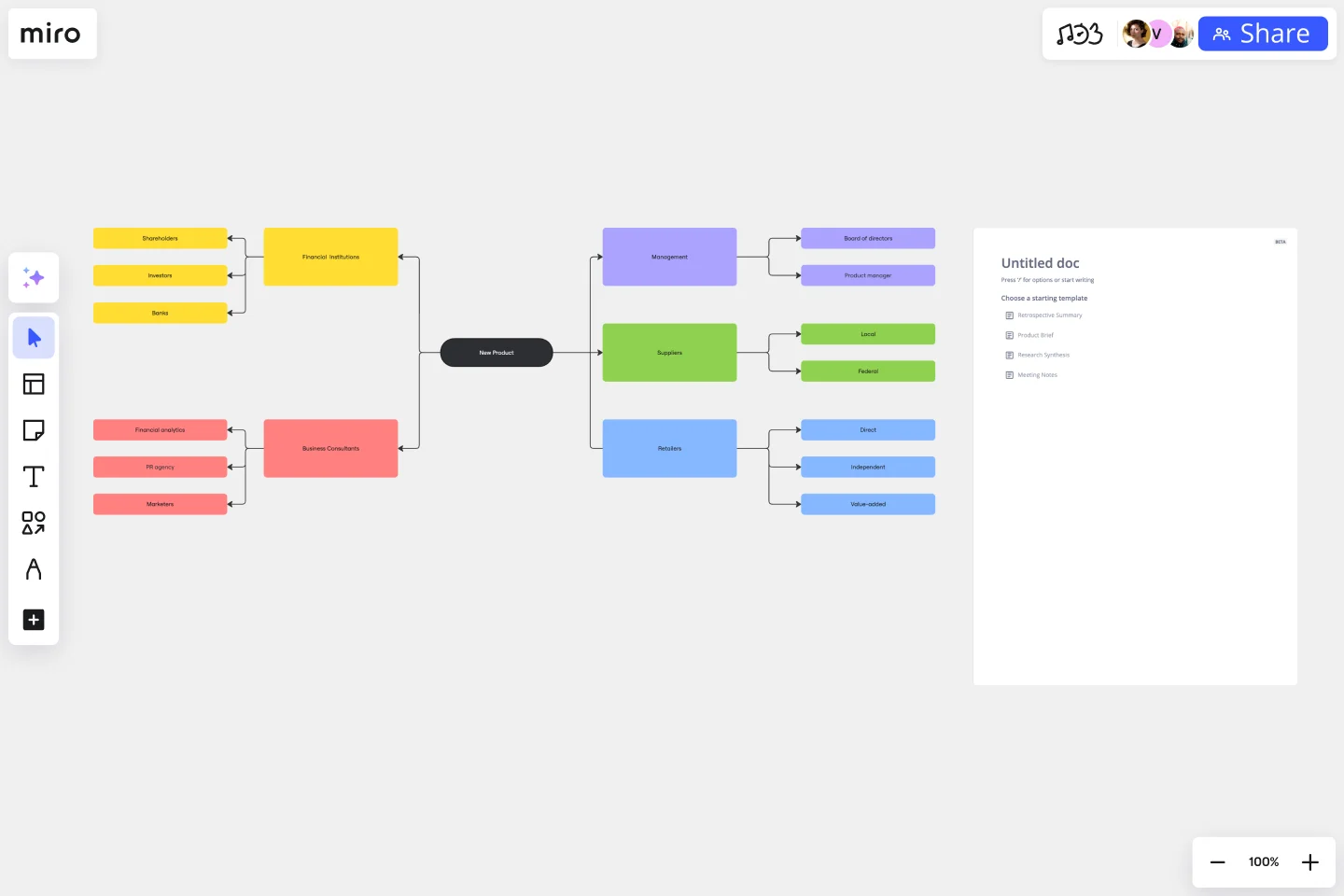Stakeholder Mapping Template
Identify and map out the people involved in a project with the stakeholder map template. Easily get buy-in and accomplish your goals.
About the Stakeholder Mapping Template
A stakeholder map is a visual tool that helps you categorize people based on their power and interests. This enables you to understand how they may influence your project or have an interest in your product or idea.
However, it is important to note that stakeholder mapping only focuses on the hierarchies within your organization, and it's a widely used project management tool at the beginning of a project. Doing it early can prevent miscommunication, ensure all groups are aligned on objectives, and set expectations about outcomes and results.
How to use the stakeholder map template in Miro
Here are the steps to follow when creating a stakeholder map:
Identify stakeholders: Begin by identifying the stakeholders relevant to your project or scenario. These could be people, groups, or organizations interested in your initiative.
Easy edititing: Double-click on each shape to add or edit content. Here, you can add details such as the stakeholder's name, role, relationship to the project, and any other relevant information.
Make it your own: Use Miro's automated diagramming features to expand your stakeholder map and categorize them accordingly.
Invite everyone to join you: If you're working with a team, use Miro's collaboration features to invite team members to the board. This enables real-time collaboration and input.
Comments and annotations: Encourage team members to add comments or annotations to the Stakeholder Map. This helps capture additional insights and perspectives.
By following these steps, you can create a comprehensive stakeholder map that includes all relevant people and groups and captures different perspectives and insights.
Why should you use a stakeholder mapping template?
Imagine starting a new project and wanting it to be as successful as possible. You should start asking these questions: Who should you involve? Who should you keep updated? Who is likely to have questions or objections?
That’s when the stakeholder mapping template comes in quite handy from the start, so you can manage stakeholders and assertively communicate with them to move your project forward.
Here are three benefits of stakeholder mapping:
Define your projects well
Stakeholders aren’t just your allies – they can also deliver insights and advice that help you shape your project. When you involve a diverse group of stakeholders from the start, they will help you create the best outline and plan for your project that will set it up for success.
Create a shared understanding from early on
Once you understand your stakeholders and who they are, you can communicate early and often develop a shared understanding of your project. If they grasp the benefits, they are more likely to support you down the line.
Secure resources
Often, stakeholders are the ones who hold the purse strings or have the necessary influence for getting you the resources you need. A stakeholder map will help you identify these individuals more quickly.
With Miro's easy-to-use strategic group mapping tools it's easy to visualize your competitive scenario.
What should a stakeholder map include?
Stakeholder maps include primarily a diagram of the people involved, interested, or signing off on your project. It can contain internal or external stakeholders and people who should be informed or consulted about your project’s development.
How can I ensure that the stakeholder map remains relevant and up-to-date?
It's important to regularly review and update the stakeholder map, especially when there are changes in organizational strategy, goals, or stakeholder relationships. This will help ensure that the map remains accurate and effective.
Get started with this template right now.
Outcome Mapping Template
Works best for:
Diagrams, Mapping, Project Management
Use Miro’s outcome mapping template to improve your operational efficiency. Outcome mapping will help you visualize all the possible strategic outcomes for your upcoming project, allowing you to see into the black box to identify any potential challenges along the way.
Product Roadmap Canvas Template
Works best for:
Roadmap, Mapping, Planning
The IASA - Product Roadmap Canvas template offers a holistic view of product development by integrating key elements such as customer needs, business goals, and technology requirements. By utilizing this canvas, teams can align their product strategy with market demands and ensure that development efforts are focused on delivering maximum value to customers.
RAID Log Template
Works best for:
Agile Methodology, Project Management, Agile Workflows
Use the RAID Log template to better understand potential risks, assumptions, issues, and dependencies relating to an upcoming project. With this information, you can make effective contingency plans and prepare your resources accordingly. You’ll know what could go wrong throughout the project and how to fix the problem.
Work Breakdown Structure Template
Works best for:
Project Management, Mapping, Workflows
A work breakdown is a project management tool that lays out everything you must accomplish to complete a project. It organizes these tasks into multiple levels and displays each element graphically. Creating a work breakdown is a deliverable-based approach, meaning you’ll end up with a detailed project plan of the deliverables you must create to finish the job. Create a Work Breakdown Structure when you need to deconstruct your team's work into smaller, well-defined elements to make it more manageable.
Manual of Me Template
Works best for:
Organizational Design
The Manual of Me template helps express personal and professional characteristics. It promotes better communication and reduces misunderstandings. This enhances productivity and fosters a more harmonious environment. The template acts as a bridge for understanding unique approaches and facilitates respectful collaboration.
STAR Technique Template
Works best for:
Strategic Planning, Prioritization
Find out how to use the STAR interview method to identify the best candidate for the role. Interviewees can also use the STAR technique to prepare detailed and thorough responses during the interview.
